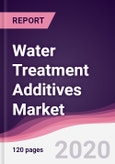What are Water treatment additives?
Water is essential for life. Hence it is important to treat water before its use. Water treatment is a process of removing contaminants such as suspended solids, microorganisms and hazardous chemicals. A large number of chemical treatment products and specialty additives are used successfully around the world in many of the commercial, municipal and industrial process environments where they help to improve productivity and optimize the treatment method.
The scientifically formulated water additives include wastewater and effluent treatment chemicals, high performance industrial chemicals, reverse osmosis membrane products, eco-friendly biological formulations, advanced polymers and much more.
This report incorporates an in-depth assessment of Water treatment Additives market by type of water treatment, type of adhesives, by applications and geography.
What are the major applications of Water treatment additives?
Water treatment additives are widely used in various industries such as water, chemicals, food, paper, power, oil and gas. These additives improve the quality of water and makes it available for a specific use. For instance, the use of disinfectants kills all the microorganisms in water and hence prevents the wide spread of water borne diseases. The treated water can be used for drinking, industrial purpose, irrigation, water recreation and so on. The different types of additives used are scale inhibitors, corrosion inhibitors, organic polymers, disinfectants, coagulants, pH conditioners and many others which help in neutralization and treatment of waste water.
Water Treatment Additives Market
Market Research and Market Trends of Water treatment additives
The Metro Wastewater Reclamation District in Denver, Colo. recently began to treat wastewater effluent with a PAA formulation from Enviro Tech Chemical Services, Inc. which is known as Peragreen WW. Though the cost of PAA is higher, this disinfectant which is preferred over sodium hypochlorite as it allows users to avoid issues associated with toxic halogenated compound such as chlorine-containing disinfectants.
Researchers at Bath University in partnership with Wessex water are testing of algal farming in order to replace the use of chemicals for treating waste water. This method is particularly suited to remove phosphorus from sewage, which is an increasing problem for water treatment and is supposed to be cheaper and more sustainable .
The wastewater obtained from hospitals include cytostatic drugs which are used in cancer treatment, not only pollute the environment but can also harm human health as these drugs don’t break down easily. A group of researchers from Belgium and India have developed a novel method of treating wastewater, in which they have developed a slurry photo catalytic membrane reactor which carries out filtration in a similar process as used for drinking water with a help of LED light source and the drugs are further broken down with the help of titanium dioxide which is nontoxic and efficient.
In rural areas, it can be very expensive to build a new water treatment plant or connect with one in the next closest town and also to have an expertise to operate it. Hence, a movable water treatment system was developed at UCLA which fits in a shipping container and can be operated with a smartphone. It can treat agricultural runoff, brackish groundwater and nearly any other water source into potable water. This system is operating successfully in Panoche water district of California since 2017 .
In 2017, Center for Nanotechnology Enabled Water Treatment (NEWT) which is located at Rice University developed a technology which involves the use of energy from sunlight to transform salt water into fresh drinking water. This desalination system uses a combination of nanophotonics and membrane distillation technique .
Who are the Major Players in Water Treatment additives market?
The market comprises several prominent players such as GE Water & Process Technologies, 3M Purification, Calgon Carbon, Aqua Tech International, Danaher, GDF SUEZ, Degremont, Veolia Water Solutions & Technologies and Siemens.
What is our report scope?
The report incorporates in-depth assessment of the competitive landscape, product market sizing, product benchmarking, market trends, product developments, financial analysis, strategic analysis and so on to gauge the impact forces and potential opportunities of the market. Apart from this the report also includes a study of major developments in the market such as product launches, agreements, acquisitions, collaborations, mergers and so on to comprehend the prevailing market dynamics at present and its impact during the forecast period 2018-2024.
Key Takeaways from this Report
Evaluate market potential through analyzing growth rates (CAGR %), Volume (Units) and Value ($M) data given at country level – for product types, end use applications and by different industry verticals.
Understand the different dynamics influencing the market – key driving factors, challenges and hidden opportunities.
Get in-depth insights on your competitor performance – market shares, strategies, financial benchmarking, product benchmarking, SWOT and more.
Analyze the sales and distribution channels across key geographies to improve top-line revenues.
Understand the industry supply chain with a deep-dive on the value augmentation at each step, in order to optimize value and bring efficiencies in your processes.
Get a quick outlook on the market entropy – M&A’s, deals, partnerships, product launches of all key players for the past 4 years.
Evaluate the supply-demand gaps, import-export statistics and regulatory landscape for more than top 20 countries globally for the market.
Table of Contents
Methodology

LOADING...








